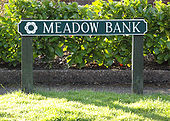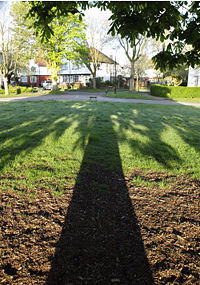
Chorltonville
Encyclopedia
Chorltonville is a garden village dating from 1911 within Chorlton
, in Manchester
, North West England
. It retains much of its original character, including architecture inspired by the Arts and Crafts movement
.
 The Chorltonville estate comprises 262 houses in twelve streets, centred on a "village green", The Meade. It measures about 500 metres east-west by 260 metres north-south--around 10.5 hectares. The estate is separated from the central part of Chorlton on the north by Chorlton Brook, and on the south side borders the Hardy Lane residential area and the fields of Hardy Farm in the Mersey Valley Countryside area. Vehicular access is via Claude Road (east) or Brookburn Road (north), and there is a footpath to Hurstville Road on the south side and another towards Hardy Farm to the south-west. The estate and an adjoining football field (owned and occupied by West Didsbury & Chorlton Football Club) are one of Manchester Council's 32 conservation areas. The designation was made in 1991.
The Chorltonville estate comprises 262 houses in twelve streets, centred on a "village green", The Meade. It measures about 500 metres east-west by 260 metres north-south--around 10.5 hectares. The estate is separated from the central part of Chorlton on the north by Chorlton Brook, and on the south side borders the Hardy Lane residential area and the fields of Hardy Farm in the Mersey Valley Countryside area. Vehicular access is via Claude Road (east) or Brookburn Road (north), and there is a footpath to Hurstville Road on the south side and another towards Hardy Farm to the south-west. The estate and an adjoining football field (owned and occupied by West Didsbury & Chorlton Football Club) are one of Manchester Council's 32 conservation areas. The designation was made in 1991.
Albert Cuneo was responsible for the design and Thomas Whiteley for the construction. Dawson and Vowles had already developed a smaller area round Darley Avenue on the site of the former Darley Hall in Old Trafford, ca. 1909. At the time most houses were not supplied with electricity though the supply in Manchester had begun nearly 20 years earlier; the Chorltonville houses were supplied both with gas and electricity so that part of the house was lit by one and part by the other.
The estate was opened on 7 October 1911 by Harry Nuttall
, MP for Stretford
. The houses were originally available for rental only, with annual rent starting at £24. They were intended to be occupied by skilled artisans, but were quickly taken over by professional families.
After the Second World War the Owners' Committee sold off the tennis courts and recreation area. The tennis courts were absorbed by gardens of adjoining Chorltonville houses, and the recreation area became a private football ground, currently owned by Chorlton & West Didsbury Football Club. Traffic calming measures have been taken on Claude Road.

, the builders attempted to make Chorltonville like a rural village using various techniques:
 Most of these features survive to the current day. Virtually all the original houses are still standing, although many have lost their stained glass. A programme of tree replacement ensures that the trees on the estate are healthy and new planting ensures their long term well being.
Most of these features survive to the current day. Virtually all the original houses are still standing, although many have lost their stained glass. A programme of tree replacement ensures that the trees on the estate are healthy and new planting ensures their long term well being.
To fund this work, all residents are liable for a levy (£155 in 2008) above the council tax
paid to Manchester City Council.
'Blues and Gospel Train' show said 'Chorltonville' the railway station used for the show was the nearby Wilbraham Road.
In 2008 the estate was used in location filming for the BBC
drama series Survivors
, as the home of Abby & David Grant.
Chorlton-cum-Hardy
Chorlton-cum-Hardy is a suburban area of the city of Manchester, England. It is known locally as Chorlton. It is situated about four miles southwest of Manchester city centre. Pronunciation varies: and are both common....
, in Manchester
Manchester
Manchester is a city and metropolitan borough in Greater Manchester, England. According to the Office for National Statistics, the 2010 mid-year population estimate for Manchester was 498,800. Manchester lies within one of the UK's largest metropolitan areas, the metropolitan county of Greater...
, North West England
North West England
North West England, informally known as The North West, is one of the nine official regions of England.North West England had a 2006 estimated population of 6,853,201 the third most populated region after London and the South East...
. It retains much of its original character, including architecture inspired by the Arts and Crafts movement
Arts and Crafts movement
Arts and Crafts was an international design philosophy that originated in England and flourished between 1860 and 1910 , continuing its influence until the 1930s...
.
Geography

History
The estate was conceived by two local businessmen, James Herbert Dawson and William John Vowles, and built between 1910 and 1911. Their objectives in building Chorltonville were:- To provide beautiful, healthy, conveniently-planned homes, with plenty of light and abundance of fresh air, at reasonable rents.
- To assist health by the provision of wide open spaces: giving ample accommodation for healthy outdoor recreation.
- By laying out a bowling green, tennis courts, and otherwise providing for the social well-being of the tenants.
- To prove that all this can be done so as to yield a satisfactory return on the capital invested.
Albert Cuneo was responsible for the design and Thomas Whiteley for the construction. Dawson and Vowles had already developed a smaller area round Darley Avenue on the site of the former Darley Hall in Old Trafford, ca. 1909. At the time most houses were not supplied with electricity though the supply in Manchester had begun nearly 20 years earlier; the Chorltonville houses were supplied both with gas and electricity so that part of the house was lit by one and part by the other.
The estate was opened on 7 October 1911 by Harry Nuttall
Harry Nuttall (politician)
Harry Nuttall was a British Liberal politician, and Member of Parliament for Stretford from 1906 to 1918.Nuttall was born in 1849 in Manchester, and attended Owens College. He was an export and import merchant, and President of the Manchester Chamber of Commerce in 1905.Nuttall unsuccessfully...
, MP for Stretford
Stretford (UK Parliament constituency)
Stretford was a parliamentary constituency in North West England, which returned one Member of Parliament to the House of Commons of the Parliament of the United Kingdom....
. The houses were originally available for rental only, with annual rent starting at £24. They were intended to be occupied by skilled artisans, but were quickly taken over by professional families.
After the Second World War the Owners' Committee sold off the tennis courts and recreation area. The tennis courts were absorbed by gardens of adjoining Chorltonville houses, and the recreation area became a private football ground, currently owned by Chorlton & West Didsbury Football Club. Traffic calming measures have been taken on Claude Road.

Characteristics of the estate
Inspired by the Arts and Crafts MovementArts and Crafts movement
Arts and Crafts was an international design philosophy that originated in England and flourished between 1860 and 1910 , continuing its influence until the 1930s...
, the builders attempted to make Chorltonville like a rural village using various techniques:
- Curved, winding streets, emulating country lanes.
- Grass verges beside the roadways.
- Numerous trees (currently there are about 360 in the public areas).
- Diverse house styles. Each pair of semi-detachedSemi-detachedSemi-detached housing consists of pairs of houses built side by side as units sharing a party wall and usually in such a way that each house's layout is a mirror image of its twin...
houses mirror each other, but are slightly different from other pairs in the same street. - Use of interesting architectural details: bay windows, tile decals on gable ends and under windows, stained glass, exposed beams.
- Two "village green" areas.

Management of the estate
Chorltonville is a private estate, owned in common by all its home owners. A committee drawn from volunteers among the owners is responsible for maintaining:- Roadways and footpaths
- Grass verges
- Trees
- Drainage gullies
- Lamp posts and street furniture
To fund this work, all residents are liable for a levy (£155 in 2008) above the council tax
Council tax
Council Tax is the system of local taxation used in England, Scotland and Wales to part fund the services provided by local government in each country. It was introduced in 1993 by the Local Government Finance Act 1992, as a successor to the unpopular Community Charge...
paid to Manchester City Council.
Cultural associations
Although the signage for the 1964 Granada TelevisionGranada Television
Granada Television is the ITV contractor for North West England. Based in Manchester since its inception, it is the only surviving original ITA franchisee from 1954 and is ITV's most successful....
'Blues and Gospel Train' show said 'Chorltonville' the railway station used for the show was the nearby Wilbraham Road.
In 2008 the estate was used in location filming for the BBC
BBC
The British Broadcasting Corporation is a British public service broadcaster. Its headquarters is at Broadcasting House in the City of Westminster, London. It is the largest broadcaster in the world, with about 23,000 staff...
drama series Survivors
Survivors (2008 TV Series)
Survivors is a British science fiction television series produced by the BBC. It depicts the lives of a group of people who survived a virulent strain of heretofore unknown influenza which has wiped out most of the human race...
, as the home of Abby & David Grant.

